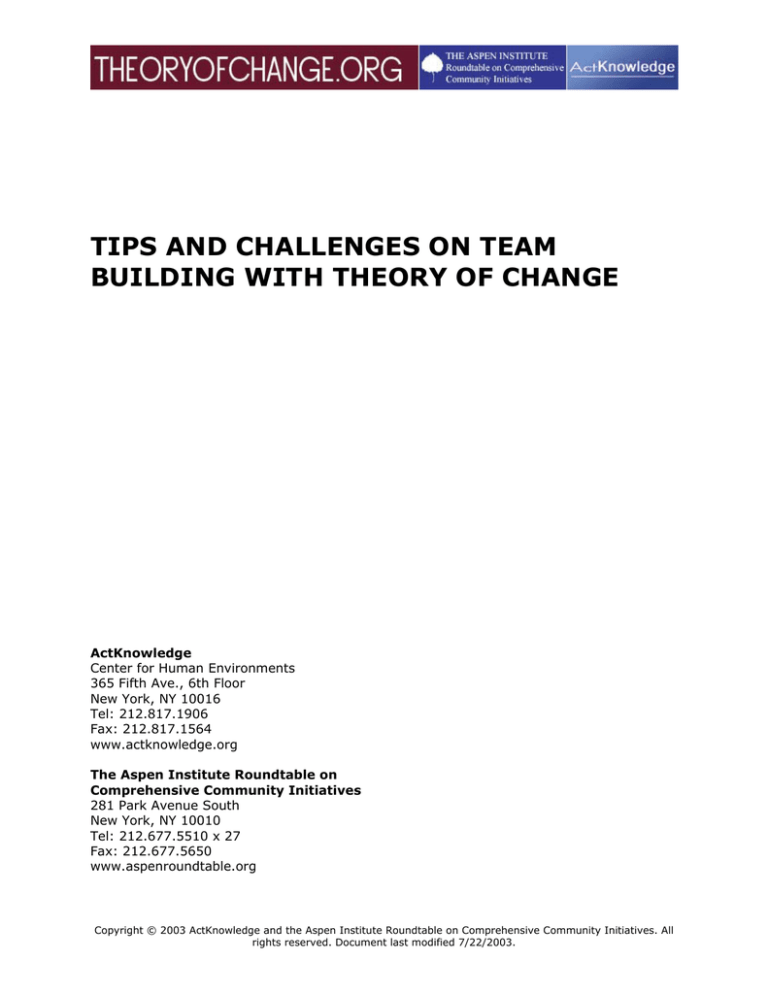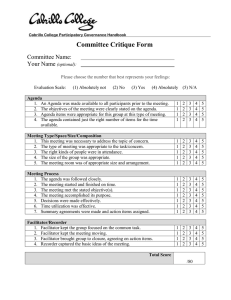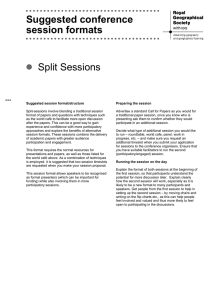
TIPS AND CHALLENGES ON TEAM
BUILDING WITH THEORY OF CHANGE
ActKnowledge
Center for Human Environments
365 Fifth Ave., 6th Floor
New York, NY 10016
Tel: 212.817.1906
Fax: 212.817.1564
www.actknowledge.org
The Aspen Institute Roundtable on
Comprehensive Community Initiatives
281 Park Avenue South
New York, NY 10010
Tel: 212.677.5510 x 27
Fax: 212.677.5650
www.aspenroundtable.org
Copyright © 2003 ActKnowledge and the Aspen Institute Roundtable on Comprehensive Community Initiatives. All
rights reserved. Document last modified 7/22/2003.
Abstract
Many individuals are interested in Theory of Change as a tool for teambuilding. In
this article, we explain why Theory of Change’s participatory process is a great
complement but not a substitute or tool for teambuilding.
Theory of Change as a “participatory” process
Many people choose to undertake building a “theory of change” for their initiative because
they believe the process is inherently participatory. What does this mean? One person can
sit down and articulate a theory of change for a program, right? Well, yes. But, we say
that being participatory is part of the theory of change process, because no theory will be as
good if it is developed without the right people at the table. In that way, participation is
inherent part of doing it well, because building a good theory requires understanding the
beliefs, resources and constraints brought to the initiative by the key players. (Key players
include the decision-makers, the program providers and at least some representation of
program recipients).
However, just because we believe that a theory will be better if the right people participate
in its development does not mean participation happens automatically. Ideally, the theory
of change process can facilitate participation because:
•
•
•
There is incentive to invite people to participate because developing a good theory
depends on hearing from relevant stakeholders.
If the theory development is well-facilitated, all voices, regardless of status outside
the room, are encouraged and listened to.
People can see where their ideas (or their role) fit in to the whole story and better
understand the big picture.
We have learned that using the theory of change process under certain circumstances can
also be detrimental to participation:
•
•
•
If the facilitator is uncomfortable with, or not well-skilled in the process, then
participants often feel confused.
If participants don’t feel ownership of the process and product (or develop a sense of
ownership as they work together), they are more likely to feel alienated.
If using the theory of change process is imposed from outside (by the funder for
example), it may seem inappropriate, culturally insensitive, “different from our way of
doing things”.
Getting a Good Theory vs. Team-Building
It is possible (but not as desirable) to develop a theory of change for an initiative without
building a good team of key players. Developing a theory and building a team that will take
ownership over the life of the initiative should go hand in hand. Yet, often, groups assume
that team building will take care of itself, or happen automatically through the process. That
is a dangerous assumption because focusing only on getting a theory done with as little
time invested as possible often puts people in a position that is detrimental to team
building.
Copyright © 2003 ActKnowledge and the Aspen Institute Roundtable on Comprehensive Community Initiatives. All
rights reserved. Document last modified 7/22/2003.
When an initiative has building a team as a priority then attention has to be paid to what
that takes. In our experience, there are a few things to keep in mind when you want to
provide the right foundation for building a cohesive team:
1. Allow enough time for people to get to know each other and develop relationships.
This is often at odds with how much time people allow to develop a “theory”, an
“evaluation”, or a “strategic plan”. In fact, trying to get a theory, evaluation or plan
done quickly puts people in a situation that may be counterproductive to team
building. They may be asked to attend too many meetings in too short a time, they
may feel pressured, they may have to work with and offer opinions with people they
haven’t had time to get to know.
2. Don’t spend too much time on one thing. People don’t want to spend months doing
nothing but arguing over their vision or their strategie, and need to feel that
something is accomplished at each meeting.
3. Provide opportunities (in or out of official meetings) for people to develop something
together and feel a sense of accomplishment over a joint task. That way, people can
observe how others work and decide on who they feel comfortable with and what
style to adapt.
4. Techniques that build relationships should be in the foreground at meetings and
“backwards mapping” or anything procedural should be in the background. A good
facilitator can make sure that the needed information comes out at a meeting
without making people feel they are being boxed into a rigid process.
5. Don’t ignore newcomers to the process. Decide beforehand how new people will be
brought into the group and brought up to speed.
Using Theory of Change for Team-building
A good theory and a good team work together to enhance each other. So, while both need
adequate attention, there is no inherent conflict between the two, rather there is a
symbiotic relationship.
But teambuilding doesn’t happen automatically just because you decide to use the Theory of
Change process. In other words, Theory of Change can be a useful team-building tool, but it
is not all that is needed to build a team that can work together. For the Theory of Change
process to also help build the team, the facilitator has to be skilled in both how to forge
relationships and create participation AND be comfortable enough with the Theory of
Change process to adapt and “work it” to that team’s particular style and needs.
Its important to remember that team building ONLY occurs when there are both time and
opportunities for people to form relationships, learn trust, and become acquainted with how
others work. So, when, a plan or evaluation has to be developed quickly, or there are very
limited human or capital resources that can be allocated, it is unlikely that the process,
whether Theory of Change or some other, is going to provide the type of setting and time
that team building needs.
Different Teams Have Different Needs
Copyright © 2003 ActKnowledge and the Aspen Institute Roundtable on Comprehensive Community Initiatives. All
rights reserved. Document last modified 7/22/2003.
Finally, we want to emphasize that the facilitator has to be as aware of, and skilled at, team
building as at Theory of Change, in order to use Theory of Change in the way that will work
best for that group. Some initiatives are bringing strangers together for the first time, who
may be suspicious of each other due to class, race, age or other differences. Some
initiatives may include people who have never done anything similar before, while others
may bring new people into situations with which they are basically experienced. On the
Sometimes, Theory of Change is undertaken by an organization and the participants all
know each other very well, but some new sense of the “big picture” or organizational roles
and mission are needed.
The point is, the facilitator needs to be thinking about who the potential participants are,
and where s/he wants to get them in terms of being a team, and the meetings and the
Theory of Change process should be organized to meet that goal.
Copyright © 2003 ActKnowledge and the Aspen Institute Roundtable on Comprehensive Community Initiatives. All
rights reserved. Document last modified 7/22/2003.



